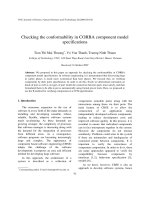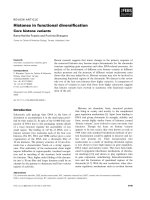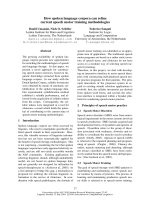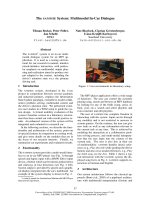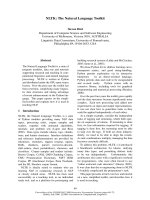Báo cáo " Using literary texts in language teaching " pptx
Bạn đang xem bản rút gọn của tài liệu. Xem và tải ngay bản đầy đủ của tài liệu tại đây (150.16 KB, 7 trang )
VNU Journal of Science, Foreign Languages 24 (2008) 120-126
120
Using literary texts in language teaching
Nguyen Thi Thom Thom
*
Department of English - American Language and Culture, College of Foreign Language,
Vietnam National University, Hanoi, Pham Van Dong Street, Cau Giay, Hanoi, Vietnam
Received 29 February 2008
Abstract. The writing reviews the potential value of using literary texts in language teaching, and
criteria for the text selection and some positive gains, which helps English language teachers teach
various skills for the first year students at the Department of English-American Language and
Culture, University of Languages and International Studies, VNU. The discussion is of great
importance in making the lessons more interesting and practical as it will effectively help students
in developing their language skills, their inspiration in study and also their confidence and
interaction with literary texts, which supplement the main objectives of the course. Also, the article
presents pedagogic practices and several suggested activities which can be used for freshmen at the
Department and in other language classrooms as well.
1. Introduction
*
The 1980 decade saw a remarkable
revival of interest in literature in language
courses. Many researchers claim that
literature has created a fresh and impressive
atmosphere in which never before have
literary texts been as highly regarded as one
of the most valuable resources available in
EFL classrooms. In this article, the author has
intention of sharing her own experience of
using literature in teaching language skills
for first year students in English Department,
College of Foreign Languages - Vietnam
National University (CFL-VNU). Also, some
suggested activities are presented to support
the practicality of exploiting literary texts in
language teaching.
______
* Tel.: 84-4-7911325
E-mail:
2. The potential value of using literary texts
in language teaching
The idea of using literary texts in EFL
classroom is supported by Sandra Mackay [1]
whose paper examines thoroughly the pros
and cons of using literature in an EFL
classroom. The author argues that "literature
can be useful in developing linguistic knowledge
both on a usage and use level." What is more, "to
the extent that the students enjoy reading literature,
it may increase their motivation to interact with a
text and thus, ultimately increase their reading
proficiency. It may also enhance students'
understanding of a foreign culture and perhaps
"spur their own creation of imaginative works."
Mortimer J. Adlert and Charles Van
Doren [2] also give the reasons for using
literary texts with classes, especially if there
is no specific examination requirement to do
Nguyen Thi Thom Thom / VNU Journal of Science, Foreign Languages 24 (2008) 120-126
121
so and little extra time available. The two
authors claim that literature is valuable
authentic material which offers "authentic"
samples of language - for example, travel
timetables, city plans, forms, pamphlets,
cartoons, advertisements, newspaper or
magazine articles. Learners are thus "exposed
to language that is as genuine and undistorted as
can be managed in the classroom context." At
least, literature can bring us a great deal of
cultural information. Adlert and Doren share
the same viewpoint with MacKay when
claiming the vital role of literature in cultural
enrichment and linguistic enrichment.
However, these two authors stress upon the
personal involvement that literature fosters
in readers. Personal involvement can be
understood as the readers' close contact with
the characters or the engagement in the event
of the story, the sharing of emotions and
feelings between readers and characters,
between readers and the author, and among
readers themselves. Therefore, students
would have a chance to learn through literary
texts in the classroom and then improve their
language awareness and cultural
understanding. Also, they would be
motivated in their learning process when
they find themselves capable of giving their
emotional responses. Personally, it would be
most advantageous when using literary texts
in teaching language, especially if the lessons
are well planned and if teachers are skilled
enough to monitor the class in an interesting
and effective way.
Another reason for choosing literary texts
is that curriculum and materials in the course
can hardly satisfy the objectives of language
teaching to first year students. Additionally,
the fact that teaching separated skills in one
lesson might not work so well encourages
teachers to resort to literary texts sometimes
so as to give students a chance of developing
overall foreign language competence. The
major problems lie on which literary
materials should be chosen and what the text
selection criteria for EFL students are. Let's
refer this to Gillian Lazar’s point of view [3].
The first year students in CFL are mostly at
lower levels, so they need to expand their
language usage in English substantially and
then expand their overall language
awareness. Despite their very limited
proficiency in the language, students also
need "the challenge and stimulation of
addressing themes and topics which have adult
appeal, and which encourage them to draw on
their personal opinions and experiences."
3. Criteria for the text selection and some
positive gains
Tran Thi Nga [4] suggests several
guidelines for selecting literary works and
genres. In the first place, appropriateness
should be taken into consideration. That is
the difficulty of a text in terms of lexis,
grammar, and style must relate to students'
levels of command of English. From her own
experience with pre-intermediate first year
students, the researcher has found the poem
"Dreams" by Langston Hughes to be quite
suitable. What the students respond to the
lesson took the author by a surprise. Second,
teachers should help students overcome
cultural barriers by informing students of
specifically cultural aspects found in the texts
to be used. Third, such factors as pleasure
and enjoyment should also be taken greater
notice of because they serve as "a motivating
factor" which inspires readers/students to
read, to be interested in reading and to
interpret the works. Nga believes that
teachers should take the position of their
Nguyen Thi Thom Thom / VNU Journal of Science, Foreign Languages 24 (2008) 120-126
122
students to ensure that the texts chosen will
appeal to students.
Generally speaking, the author shares the
same viewpoints with the researchers above.
Nevertheless, the teaching objectives would
be somewhat different. A stanza of a poem,
for instance, might bring teacher and
students an interesting way to drill the
sounds /s/, /z/, /S/ and ending sounds in a
pronunciation lesson:
And we will sit upon the rocks,
Seeing the shepherds feed their flocks,
By shallow rivers to whose falls
Melodious birds sing madrigals.
(The passionate shepherd to his love-
Christopher Marlow)
Likewise, with a short story, teachers may
take into account the use of linguistic items to
help students revise the grammar first and
then basing on the grammar focus to practise
other language skills as speaking and
writing. Certainly, learners' interpretive
ability will also be paid attention to during
the process. It might be rewarding because
the level of difficulty is not too much above
the students' normal reading proficiency and
the content is both interesting and relevant to
the students' background knowledge. This
will encourage students to get personally
involved in the text and build their own
interpretation at a basic level. Speaking and
writing, furthermore, offer them a chance to
drill in the language and to express their
output ability. Put it in another way, the text
can give them valuable opportunities to use
and develop such sub skills as deduction of
meaning from linguistic and situational
context, relating text to knowledge and
experience of the world, responding to text,
creative writing, etc. Beside skill
development, the story will also provide
educational value, affective value, individual
value and stimulus value as mentioned in
Brian Tomlinson's article [5].
4. Pedagogic approach
Carter and Long (quoted in Zafeiriadou,
[6]) describe the three main models related to
specific pedagogic practices: the cultural
model, the language model and the personal
growth model. The first two models focus on
the study of literature while the personal
growth model puts an emphasis on the use of
literature as a resource, aiming to the
development of language competence and
literary competence, being better expressed
in terms of pleasure and personal fulfillment.
Rather, this model aims to "infuse a
continuous love and appreciation of literary texts,
which would continue beyond the classroom."
Furthermore, in this model, the teacher is
suggested to play a role as an educator and
an enabler for the transmission of knowledge
rather than a traditional possessor of
knowledge whose beliefs greatly impose on
students. This is meant to motivate and
enliven students in the classroom.
The lesson, therefore, might be designed
into certain tasks. The structure of the task is
composed of: i) specific goals or outcomes; ii)
some input data (in the literary texts); and iii)
one or more related activities or procedures.
In other words, the task frame (Le Van Canh,
[7]) is as the following:
Nguyen Thi Thom Thom / VNU Journal of Science, Foreign Languages 24 (2008) 120-126
123
Preparation: Teacher (and sometimes students) prepare some suitable materials before hand
Pre-task (Warm-up): To prepare students for the task, to engage their attention
Task: To give students the chance to take part in the activities
Planning: Students prepare their oral report of the task
Report: Students present the report
Post-task activity: For example, listening or exchanging the ideas among the groups
Language focus: To raise students' awareness about target language
Language practice: To give students some restricted written target language
Optional follow up: To give students an opportunity to repeat (and hopefully improve) the task
A task, therefore, covers several skill areas,
hardly just one, so Task-based teaching is a
well-integrated approach to language teaching
in general, and to the using of literary texts in
teaching language skills in particular.
5. Suggested activities
There might be a variety of activities
exploited from literary texts. However, the
researcher focuses on the use of short stories
to teach the language in an integrative lesson.
Some practical suggestions should be
considered as below:
a) Strong lines (Elisabeth B. Ibsen [8])
- Students are required to read a short
story before hand. In the class, however, they
are not allowed to look at the story when
following this activity.
- In the class, teacher asks students to have
a quick look at the whole story and underline
"strong lines" that is the words and expressions
that they like or that disturb them.
- Divide the class into groups of three or
four and ask students to share the strong
lines with other members in their group.
Note: When sharing "strong lines" in
class, students may discover that they often
select the same lines- that is, they all
appreciate lines of good literary quality. In
this way, the teacher can help students to
identify good qualities in a literary text,
which again can benefit their own writing.
- All the members in one group discuss
and choose one "strong line" favoured by
most members (they can vote if needed.)
- Use the "strong line" as the title or the
topic for an expressive piece of writing. For
example, write your comments on the
sentence above.
(Note: All the group members are
supposed to contribute to the group's project.
The teacher may help students when they
have difficulty in interpreting the title or the
topic of their strong line.)
-Ask each group to report their project.
Make a class exhibition if possible.
b) Storytelling
- Students are required to read the short
story before hand.
- The teacher picks up 10-15 words from the
passage. Write the words (in the sequence of
occurrence in the text) on the board. For
example,
1. news 6. knock
2. killed 7. gentle
3. message 8. blurted
4. loitered 9. nightgown
5. farmhouse 10. bang
(The Corn Planting-Sherwood Anderson)
- Give students one minute to memorise
the words.
- Cross out all the words. Ask students to
rewrite the words in order within 1 minute.
- Check students' word list. Those who
can write the most words are the winners.
(Gifts should be available in this activity)
Nguyen Thi Thom Thom / VNU Journal of Science, Foreign Languages 24 (2008) 120-126
124
- Note: in fact, one effective way of
memorising all the word is that students put
the words in sentences related to the passage. If
so, they can recall the content of the passage.
- Ask students to tell the content of the
passage (they can work individually or in
pair/group works), using the word lists.
Then, ask them to write.
- Optional***: Ask students to use the
word list to make up a new story. It would be
more challenging if the teacher asks them to
work in pairs and each pair creates 2 stories
by using the words from top to bottom and
from bottom to top. Students should make
use of their imagination. For example:
Student A: "Last night, I got a terrible
piece of news. My beloved pet bird got killed
by a neighbour's fierce cat "
Student B: "I was sleeping last night when
I was suddenly woken up by a bang. I got out
of my bed and went into the kitchen to see
what happened. There I saw a stranger in a
white nightgown "
- Ask students to tell their stories (The
class may choose the best stories). Ask them
to write their own story as a home task.
c) Gap filling
- Students are required to read the story
before hand. In the class, however, they are
not allowed to look at the story when
following this activity.
- Teacher prepares another copy of the text
in which there are some gaps for the students
to fill in. The gaps can be passive vocabulary,
adjective vocabulary, etc so that students will
have a chance to revise the lexis later.
- Ask students to fill in the gaps,
exchange the answers in pair/group.
- Remind them of the related
grammatical focus.
- Give them a chance to drill in the
language/grammar if possible.
Example:
Teacher can leave out the relative
pronouns (who, which, where, when ) or
adjectives of describing the people (Later, ask
students to use those adjectives to describe
the characters in the story.)
d) Storylines ( Allan Malley, [9])
- Students are not provided with the text
before the lesson.
- From each part of the story, select one or
two key sentences, that is, ones which give an
indication of the storyline. Write out these
sentences in order and make them up into a
task sheet. If teacher wishes to make the
activity slightly easier, he/she could also add
the opening paragraph and the ending.
- Ask students to work in groups of three.
Give each group a copy of the task sheet.
Students discuss what they think happen in
the story, and find a possible explanation for
each of the sentences.
- The groups compare their different
versions of the story
- Class discussion: Ask the class to call
out those sentences from the story which
they found most difficult to explain. Let them
compare their suggestions. Finally reveal
what actually happened in the story.
- Note: Although the activity is best
suited to unfamiliar material, it can also be
used as a form of memory test to refresh
familiar texts, and it is particularly suitable
for revising set works or texts which may
feature in examination.
This activity helps to overcome one of the
main difficulties of working with literature in
class: how to deal with longer texts. Here, the
students are in a sense of skimming through
a longer text which they may read later on
their own. Teacher will find out that the
interest aroused is usually great and that, by
the end of the activity, the students actually
want to read the whole text. This eagerness to
Nguyen Thi Thom Thom / VNU Journal of Science, Foreign Languages 24 (2008) 120-126
125
know what happens is not easily aroused
when students are simply asked to plod
through the text page by page.
- Optional***: this activity can be
modified into a Prediction Game. The teacher
reads/plays the tape of a part of the story and
stop to ask students to guess what the author
is going to write about, what happens next. It
would be most useful when students are
asked to predict the ending. Later, they will
have a chance to compare their works with
the original texts. A Follow-up activity might
be the oral summary of the story or another
ending. If the students are greatly interested
in the activity, then the teacher can ask them to
write any part of the story in their own words,
or change the plot at any part they like.
e) Creative writing (as Home Tasks)
Often, the home task should be a piece of
creative writing. Teacher may ask students to
write what they feel and respond after
reading the story. This is some what like
asking about their personal interpretation.
Plot summarizing is also a good idea as Paula
Willoquet Maricondi [10] states: "This
assignment is both a record and an act of
understanding." Another home task might be
student's research on the author or their
comments on some strong lines. For instance,
Comment on the last sentence of the story.
Create a new version from the ending of the story.
6. Conclusion
In this article, the author has just made an
attempt to express her personal philosophy
for using literary texts in language learning
classrooms, basing on her real working
condition. It is undeniable that even when
the texts are mainly used for skill
development in the lessons, the holistic value
of literature is to be discovered to the most
possible extent as in Baurain's opinion:
"Knowing what your students need, want,
lack, and desire in their study of literature is
a key of success."[11]
References
[1] S. MacKay, Literature in the ESL Classroom,
TESOL Quarterly 16 (4) (1982) 529.
[2] M.J. Adler, How to read Imaginative Literature,
Oxford University Press, 1972.
[3] G. Lazar, Using Literarure at Lower Level, Oxford
University Press, ELT Journal 48 ((1994) 115.
[4] Tran Thi Nga, Incorporating Literature into
English Classes in Vietnam, Teacher's Edition, 1 -
March, 2003.
[5] B. Tomlinson, Using Poetry with Mixed Ability
Language Classes, Oxford University Press,
ELT Journal 40 (1986) 33.
[6] N. Zafeiriadou, On Literature in the EFL classroom,
TESOL Greece Newsletter, Greece,, 2001.
[7] Le Van Canh, Lecture Notes on Methodology in
Language Teaching, Vietnam National
University, Hanoi, 2004.
[8] E.B. Ibsen, The Double Role of Fiction in Foreign
Language Learning: Towards a Creative
Methodology, English Teaching Forum, 1990.
[9] A. Maley, Literature, 9th ed: Oxford University
Press, 2000.
[10] P. Maricodi, Integrating ESOL Skills Through
Literature, TESOL Journal, Winter (1991) 12.
[11] B. Baurain, Learning and Enjoying Literature in
English, Teacher's Edition 3 - September, 2000.
Nguyen Thi Thom Thom / VNU Journal of Science, Foreign Languages 24 (2008) 120-126
126
Sử dụng ngữ liệu văn học
trong giảng dạy các kỹ năng thực hành tiếng
Nguyễn Thị Thơm Thơm
Khoa Ngôn ngữ và Văn hóa Anh - Mỹ, Trường Đại học Ngoại ngữ,
Đại học Quốc gia Hà Nội, Đường Phạm Văn Đồng, Cầu Giấy, Hà Nội, Việt Nam
Bài viết trình bày giá trị tiềm năng của việc sử dụng ngữ liệu văn học trong giảng dạy các kỹ
năng thực hành tiếng và các tiêu chí lựa chọn ngữ liệu văn bản phù hợp với chương trình ngoại
khóa cho sinh viên năm thứ I Khoa Ngôn ngữ và Văn hóa Anh - Mỹ, Trường Đại học Ngoại ngữ,
Đại học Quốc gia Hà Nội. Những phân tích này rất quan trọng trong việc góp phần xây dựng các
bài học hấp dẫn hơn, giúp sinh viên phát triển các kỹ năng ngôn ngữ, tính tự giác trong học tập
và cả sự tự tin và tương tác với các ngữ liệu văn học vốn vẫn thường được coi là khó tiếp cận. Bài
báo cũng đưa ra các phương pháp giáo học pháp cơ bản và có tính ứng dụng nhất định, đồng
thời cung cấp những hoạt động giảng dạy cụ thể đã được lựa chọn và áp dụng hiệu quả cho sinh
viên năm thứ nhất của Khoa cũng như với một số đối tượng học viên khác.
